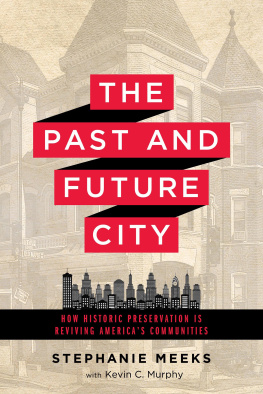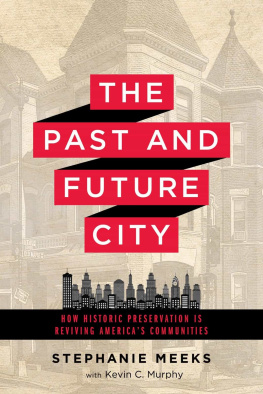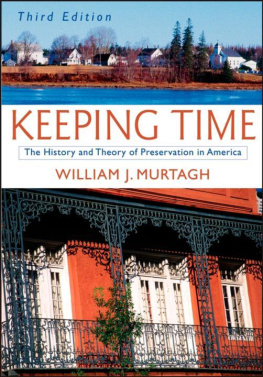The National Historic Preservation Act
The National Historic Preservation Act: Past, Present, and Future
Edited by
KIMBALL M. BANKS AND ANN M. SCOTT
First published 2016
by Routledge
711 Third Avenue, New York, NY 10017
and by Routledge
2 Park Square, Milton Park, Abingdon, Oxon OX14 4RN
Routledge is an imprint of the Taylor & Francis Group, an informa business
2016 Taylor & Francis
The right of Kimball M. Banks and Ann M. Scott to be identified as the authors of the editorial material, and of the authors for their individual chapters, has been asserted in accordance with sections 77 and 78 of the Copyright, Designs and Patents Act 1988.
All rights reserved. No part of this book may be reprinted or reproduced or utilised in any form or by any electronic, mechanical, or other means, now known or hereafter invented, including photocopying and recording, or in any information storage or retrieval system, without permission in writing from the publishers.
Trademark notice: Product or corporate names may be trademarks or registered trademarks, and are used only for identification and explanation without intent to infringe.
Library of Congress Cataloging-in-Publication Data
A catalog record for this book has been requested
ISBN: 978-1-62958-295-5 (hbk)
ISBN: 978-1-315-52085-8 (ebk)
Typeset in Minion Pro
by Leyba and Associates.
CONTENTS
List of Tables
Jerry L. Rogers
Marion F. Werkheiser, L. Eden Burgess, and Cameron Green
Reid J. Nelson
Kimball M. Banks and Renee M. Boen
Fern E. Swenson, Paul R. Picha, and Amy C. Bleier
Rebecca A. Hawkins
Darby C. Stapp
Michael J. Moratto
Sarah A. Herr and Beth Grindell
Kimball M. Banks, Craig Lee, and Damita Engel
Duane E. Peter, Ann M. Scott, and Nancy Kenmotsu
Ronald J. Rood and Kimberly Kintz
Rhiannon Jones and Donald Weir
Patrick H. Garrow
Lyle C. Torp
Lynne Sebastian
Jerry L. Rogers
INTRODUCTION
I t was not quite a new beginning for the National Park Service (NPS) when the National Historic Preservation Act (NHPA) was signed into law by President Lyndon B. Johnson on October 15, 1966, but it almost was. Although in its 50 years of existence the Service had learned useful lessons in preserving and managing places that were nationally significant in history, architecture, archaeology, and culture and had developed experience in documenting historic buildings and salvage of threatened archaeological sites on lands it did not manage, the new law called for much more. States were now to have a role, that role was supposed to be planned comprehensively, and places previously dismissed as not worthy of consideration because not nationally significant were now to be listed in an expanded National Register of Historic Places and could no longer be routinely destroyed by federal undertakings. The trouble was that there were no State Historic Preservation Officers, only a few statewide historic marking programs, and no one knew what a state preservation plan might be nor how one could recognize a place that was worthy of National Register listing and preservation under the new broadened concept.
The Service had not been taken by surprise, however. Two years earlier, Ronald F. Lee had persuaded the visionary director George B. Hartzog that NPS needed to catch up to philosophical changes that were taking place in the historic preservation field, and they had put Chief Historian Robert M. Utley in charge of making that happen. Utley saw to it that the Service played a significant role in conceiving the Act and getting it passed; and to put it into effect, Hartzog assigned Utley to combine the Services archaeologists, historians, and historical architects into a single high-level administrative entity called the Office of Archeology and Historic Preservation (OAHP). Ernest Allen Connally, an erudite and popular professor of architecture from the University of Illinois, began duty as chief of the Office of Archeology and Historic Preservation on June 19, 1967, the same day that Jerry Rogers joined OAHP as a historian and management intern with the National Register of Historic Places.
The Act also created the Advisory Council on Historic Preservation (ACHP), with cabinet officers of several relevant federal agencies plus prominent citizens appointed by the president as members. Robert R. Garvey left his leadership post at the National Trust for Historic Preservation to become the first executive secretary of the council. Garvey possessed an exceptional ability to assess a controversial situation, to identify the best courses of action, and to steer things toward his desired outcome.
Even today, it remains difficult to maintain harmony among the wide array of professional specialties that are involved in the work authorized by the NHPA, and creating such harmony was one of Connallys first challenges. Most of the NPS programs that were pulled into the OAHP had been organized around the academic disciplines of history, architecture, and archaeology, and these programs had worked out clear understandings of their jobs and how to do them. The history programs knew well how to study American history within a carefully reasoned thematic structure in order to determine which places qualified to be National Historic Landmarks or units of the national park system and how to tell their stories. The architecture programs were also fully confident of their abilities and practices, particularly the Historic American Buildings Survey (HABS), which since 1933 had carefully cultivated its own identity and a very single-minded constituency of outside supporters and funders. The archaeology programs were also driven by funding sources outside the NPS and far beyond Connallys control or influence. Only the tiny National Register program at the heart of the consolidated OAHP was actually new, and it was dependent upon the experience and goodwill of people in the older programs. The new law and new organization meant interference with heretofore successful routines, and it made increased interdisciplinary cooperation essential. Connally was aided in his unifying work by his own past experience as a HABS team leader and that of NPS architect Russell V. Keune, by having William J. Murtagh as the expansive-minded first Keeper of the National Register, and by the cooperation of several respected individuals in the archaeological world, notably John O. Brew, Emil W. Haury, and Raymond H. Thompson. Over time, however, Connallys success proved largely due to the advance preparation, quiet leadership, scholarly reputation, and bureaucratic savvy of Robert Utley.
Many precedents were drawn upon to get things going, but each had limited applicability. Other nations had highly sophisticated programs to protect what were generally called monuments, but they relied upon legal systems that permitted the sovereign to control private propertysomething that American state and local governments can do but federal government cannot, and which is politically unpopular at any level. A handful of American cities had conducted extensive surveys and gained experience identifying, registering, and protecting historic places, but these were almost exclusively architectural and were highly skewed by the dominant cultures positive view of itself. The few state programs that marked historic sites were driven by the energy of local volunteers and were hardly systematic or comprehensive. Archaeologists were conducting surveys in special places like national monuments and in places about to be inundated by new reservoirs or destroyed by pipelines and other projects, but these surveys were substantially designed








